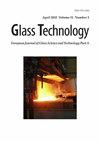Characterisation and Performance of Nigerian Kaolin and Metakaolin in Geopolymer Synthesis
IF 0.3
4区 材料科学
Q4 MATERIALS SCIENCE, CERAMICS
Glass Technology-European Journal of Glass Science and Technology Part a
Pub Date : 2023-07-27
DOI:10.47672/ejt.1542
引用次数: 0
Abstract
This study is aimed at characterising and understanding the mechanical and microstructural behaviour of natural and calcined kaolin clay for geopolymer applications. The clay samples obtained from Kaduna State, Northern area of Nigeria, were calcined within the temperature range of 700 and 900oC and are represented by MK7, MK8 and MK9. The raw kaolin and metakaolin were characterized by X-ray diffraction (XRD), X-ray fluorescence (XRF) and scanning electron microscopy (SEM). To produce geopolymer binders, the precursors were reacted with a 1:1 combination of sodium hydroxide and sodium silicate solution and a precursor to activator ratio of 1.2 was suitable for preparation. The compressive strength of the samples was determined at three testing age of 7, 14 and 28 days. From the results obtained, the kaolin-based geopolymer generally had a long setting time and testing was impossible at the 7-day testing age. The compressive strength of other samples however, increased with increase in the calcination temperature. The values obtained at the maximum testing age of 28 days for all samples fall between 5.1 -14.9 MPa. The scanning electron microscope morphology of the produced binder, show the presence of air trapped in the paste which may have reduced the strength value. Vibrating samples before setting can improve the performance of the geopolymer binders by removing most of the trapped air. Geopolymers produced from this study based on strength obtained, can be used in less critical areas of the construction industry.尼日利亚高岭土和偏高岭土在地聚合物合成中的表征及性能
本研究旨在描述和理解用于地聚合物应用的天然和煅烧高岭土粘土的机械和微观结构行为。黏土样品取自尼日利亚北部卡杜纳州,煅烧温度范围为700 ~ 900℃,以MK7、MK8、MK9为代表。采用x射线衍射(XRD)、x射线荧光(XRF)和扫描电镜(SEM)对原料高岭土和偏高岭土进行了表征。为了制备地聚合物粘结剂,将前驱体与氢氧化钠和硅酸钠溶液以1:1的比例反应,前驱体与活化剂的比例为1.2。分别在7、14、28天三个试验龄期测定试样的抗压强度。从结果来看,高岭土基地聚合物一般凝结时间较长,在7天的测试龄期无法进行测试。其他试样的抗压强度随煅烧温度的升高而升高。在最大试验龄期28 d时,所有试样的应力值均在5.1 ~ 14.9 MPa之间。所制粘合剂的扫描电镜形貌显示,膏体中存在空气,这可能降低了强度值。在凝固前对样品进行振动可以通过去除大部分被困空气来改善地聚合物粘合剂的性能。根据所获得的强度,本研究生产的地聚合物可用于建筑行业的不太关键的领域。
本文章由计算机程序翻译,如有差异,请以英文原文为准。
求助全文
约1分钟内获得全文
求助全文
来源期刊
CiteScore
0.30
自引率
0.00%
发文量
0
审稿时长
>12 weeks
期刊介绍:
The Journal of the Society of Glass Technology was published between 1917 and 1959. There were four or six issues per year depending on economic circumstances of the Society and the country. Each issue contains Proceedings, Transactions, Abstracts, News and Reviews, and Advertisements, all thesesections were numbered separately. The bound volumes collected these pages into separate sections, dropping the adverts. There is a list of Council members and Officers of the Society and earlier volumes also had lists of personal and company members.
JSGT was divided into Part A Glass Technology and Part B Physics and Chemistry of Glasses in 1960.

 求助内容:
求助内容: 应助结果提醒方式:
应助结果提醒方式:


